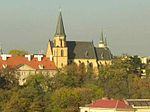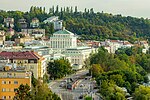Church of the Assumption of the Virgin Mary and St. Charles the Great, Prague
Gothic architecture in the Czech RepublicJan Santini Aichel buildingsNational Cultural Monuments of the Czech RepublicRoman Catholic churches in the Czech Republic
The Church of the Assumption of the Virgin Mary and St. Charles the Great is located in the Karlov area of Prague. The originally Gothic church was rebuilt and augmented in baroque style. The church is a part of the former convent of the Augustinian Order in Prague's Karlov.
Excerpt from the Wikipedia article Church of the Assumption of the Virgin Mary and St. Charles the Great, Prague (License: CC BY-SA 3.0, Authors).Church of the Assumption of the Virgin Mary and St. Charles the Great, Prague
Horská, Prague New Town
Geographical coordinates (GPS) Address External links Nearby Places Show on map
Geographical coordinates (GPS)
| Latitude | Longitude |
|---|---|
| N 50.068611111111 ° | E 14.428333333333 ° |
Address
Panna Maria a svatý Karel Veliký
Horská
128 00 Prague, New Town
Prague, Czechia
Open on Google Maps











